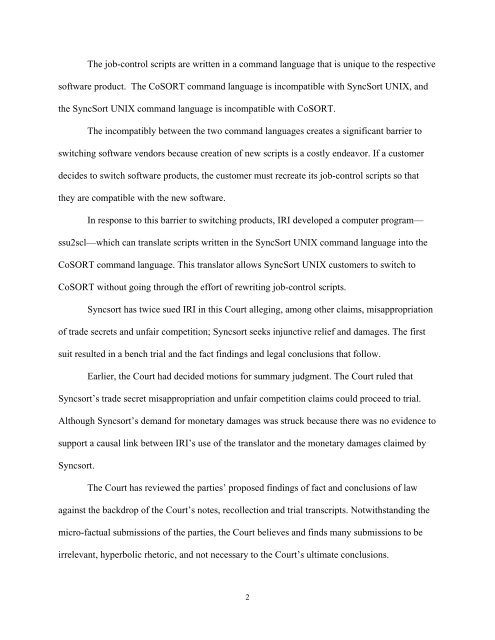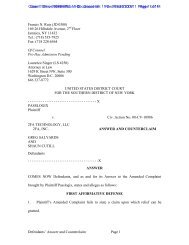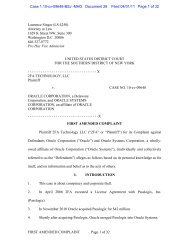Syncsort v. Innovative Routines.pdf - Trade Secrets Institute
Syncsort v. Innovative Routines.pdf - Trade Secrets Institute
Syncsort v. Innovative Routines.pdf - Trade Secrets Institute
- No tags were found...
Create successful ePaper yourself
Turn your PDF publications into a flip-book with our unique Google optimized e-Paper software.
The job-control scripts are written in a command language that is unique to the respectivesoftware product. The CoSORT command language is incompatible with SyncSort UNIX, andthe SyncSort UNIX command language is incompatible with CoSORT.The incompatibly between the two command languages creates a significant barrier toswitching software vendors because creation of new scripts is a costly endeavor. If a customerdecides to switch software products, the customer must recreate its job-control scripts so thatthey are compatible with the new software.In response to this barrier to switching products, IRI developed a computer program—ssu2scl—which can translate scripts written in the SyncSort UNIX command language into theCoSORT command language. This translator allows SyncSort UNIX customers to switch toCoSORT without going through the effort of rewriting job-control scripts.<strong>Syncsort</strong> has twice sued IRI in this Court alleging, among other claims, misappropriationof trade secrets and unfair competition; <strong>Syncsort</strong> seeks injunctive relief and damages. The firstsuit resulted in a bench trial and the fact findings and legal conclusions that follow.Earlier, the Court had decided motions for summary judgment. The Court ruled that<strong>Syncsort</strong>’s trade secret misappropriation and unfair competition claims could proceed to trial.Although <strong>Syncsort</strong>’s demand for monetary damages was struck because there was no evidence tosupport a causal link between IRI’s use of the translator and the monetary damages claimed by<strong>Syncsort</strong>.The Court has reviewed the parties’ proposed findings of fact and conclusions of lawagainst the backdrop of the Court’s notes, recollection and trial transcripts. Notwithstanding themicro-factual submissions of the parties, the Court believes and finds many submissions to beirrelevant, hyperbolic rhetoric, and not necessary to the Court’s ultimate conclusions.2








